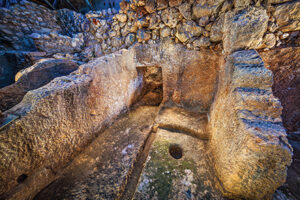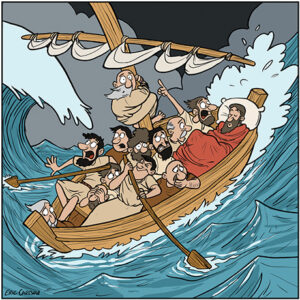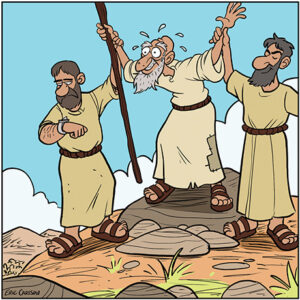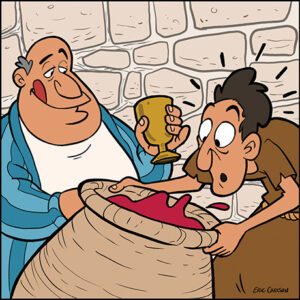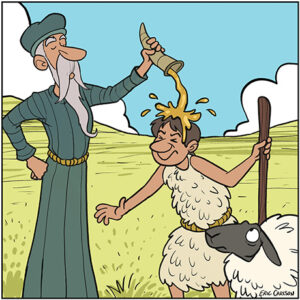Who Did It?
Whose studies of Levantine village life identified folklore and traditions that extended back to biblical times?
Answer: Tawfiq Canaan
Tawfiq Canaan (1882–1964) was a Palestinian physician who spent his career in Jerusalem. He was a gifted and prolific medical researcher, authoring nearly 40 studies ranging from tuberculosis and malaria to health conditions in Palestine; he also contributed to research that led to a cure for leprosy.
Parallel to his medical career, however, Canaan was deeply engaged in the study of Palestinian folk traditions and culture, producing several books and more than 50 articles in this field. He stood at the heart of an intellectual circle that understood rural communities to be the inheritors of the region’s cultural legacy dating back to pre-biblical times. Publishing regularly in the Journal of the Palestine Oriental Society in the 1920s and ’30s, Canaan developed a rich, vibrant, and sensitive body of knowledge about the beliefs and traditions of the residents of the southern Levant that he believed was essential to understanding the earlier Canaanite, Israelite, Philistine, Nabatean, Aramean, and Arab inhabitants of the region.
Canaan’s upbringing was steeped in the German Lutheran tradition; his father, the first Arab pastor for the German Protestant Palestine Mission, founded the first Lutheran church, YMCA, and co-ed school in their home village of Beit Jala, near Jerusalem. Thanks in part to this background, Canaan was able to maintain close ties with European intellectuals over the course of his career, including biblical scholars such as Albrecht Alt, Martin Noth, and his lifelong friend, archaeologist William F. Albright, who headed the American School of Oriental Research in Jerusalem during the 1920s.
Jerusalem Cult Shrine Discovered
On the eastern slope of the City of David, just a few hundred yards from the ancient Temple Mount, archaeologists discovered a substantial 2,300-square-foot structure, partially carved into the rocky hillside, that appears to have been a cult shrine. Originally constructed by the end of the Middle Bronze Age (c. 1550 BCE), the site has yielded clear evidence of cultic activity well into the time of the biblical kings (c. 1000–586 BCE).
In the building’s eight rock-cut rooms were several installations, including an altar, a standing stone (massebah) representing the deity, a winepress, and an olive press. The presses may have been used to prepare offerings to the shrine’s deity. The altar installation, which included a drainage channel, may have been where sacrifices were made. Another room revealed strange V-shaped crevices carved into the floor, the purpose of which remains a mystery.
Although cult sites outside the Jerusalem Temple have been discovered in various locations throughout the biblical kingdom of Judah, such as Arad, Lachish, and Moza, the proximity of this building to the Temple Mount likely precludes the possibility that it was dedicated to the Israelite God Yahweh. Archaeologists believe the shrine went out of use in the late eighth century, coinciding with the reforms of King Hezekiah (2 Kings 20:4–5).
Authors
Susan Ackerman (Women and Prophecy in Biblical Israel) is a retired professor of religion and women’s and gender studies at Dartmouth College. She specializes in women and the religion of ancient Israel.
Zeba Crook (Book Review: The Quest for John the Baptist) is Professor of Religion at Carleton University in Ottawa, Canada. He focuses on Christian origins and the historical Jesus.
Guy Darshan (The Table of Nations: A Geographic Odyssey) is Associate Professor in the Department of Biblical Studies at Tel Aviv University in Israel. He specializes in biblical literature.
Shimon Gibson (The Mysterious Mount Zion Mug) is Professor of Practice in the History Department at the University of North Carolina, Charlotte. He co-directs the Mt. Zion excavations.
David Hamidović (Deciphering the Inscription) is Professor in the Department of Theology and Religious Sciences at the University of Lausanne, Switzerland. He specializes in Jewish apocryphal literature.
James K. Hoffmeier (Judah’s African Ally: Taharqa and the Kingdom of Cush) is Professor Emeritus of Old Testament and Near Eastern Archaeology at Trinity Evangelical Divinity School.
Aaron Koller (Milestone: Clinton Bailey (1936–2025)) is Professor of Near Eastern Studies at Yeshiva University. He studies Semitic languages and history.
Rafael Y. Lewis (Real Households of Jerusalem) is a senior lecturer at Bar-Ilan University in Israel and a field archaeologist specializing in the archaeology of Jerusalem. He co-directs the Mt. Zion excavations.
Carolina López-Ruiz (From Tyre to Tarshish: The Phoenicians in Spain) is Professor of Ancient Mediterranean Religions and Mythologies at the University of Chicago. Her work examines cultural exchange in the Mediterranean world.
Megan Nutzman (Heavenly Help: Christian Amulets in Context) is Associate Professor of History at Old Dominion University. Her focus is religion in the ancient Mediterranean world.
Steve Patterson (Real Households of Jerusalem) is SPX Distinguished Professor of Mechanical Engineering and Engineering Science at the University of North Carolina, Charlotte.
David Schloen (From Tyre to Tarshish: The Phoenicians in Spain) is John A. Wilson Professor of Archaeology and Digital Humanities at the University of Chicago. He specializes in the archaeology and history of the Levant in the Bronze and Iron Ages.
Lily Singer-Avitz (Milestone: Ze’ev Meshel (1932–2024)) is a researcher in the Institute of Archaeology at Tel Aviv University. She specializes in the archaeology of the biblical period.
James R. Strange (Site-Seeing: Exploring Jesus’s Hometown) is the Charles Jackson Granade and Elizabeth Donald Granade Professor in New Testament at Samford University.
José Suárez Padilla (From Tyre to Tarshish: The Phoenicians in Spain) is Professor of Historical Sciences at the University of Málaga, Spain. He specializes in the archaeology of ancient Iberia.
James D. Tabor (Real Households of Jerusalem) is a retired professor of early Christianity at the University of North Carolina, Charlotte, and Distinguished Fellow at Hebrew University of Jerusalem. He co-directs the Mt. Zion excavations.
Yoav Vaknin (Dating Game: How Archaeologists Date the Biblical Past) is a postdoctoral fellow at the University of Bern and a paleomagnetic researcher at the Hebrew University of Jerusalem.
Caption Contest
“Hey Jesus, remember that ‘walking on water’ thing that Peter did?”
—Dennis Hefty, Salem, Oregon
Thank you to all those who submitted caption entries for our Winter 2024 cartoon (right), based on Matthew 8:24–26: “A windstorm arose on the sea, so great that the boat was being swamped by the waves; but [Jesus] was asleep. And they went and woke him up, saying, ‘Lord, save us! We are perishing!’ And he said to them, ‘Why are you afraid, you of little faith?’” We are pleased to congratulate Dennis Hefty of Salem, Oregon, who wrote the winning caption, and our runners-up:
RUNNERS-UP
“I know you said we need to be baptized, but I think you’re going a little overboard this time!”
—Gen Dorn, Mesa, Arizona
“Wake up! The BAS Seminar at Sea brochure didn’t mention this!”
—Kent Atwood, Clancy, Montana
HONORABLE MENTIONS
“Anything you ask, Lord, but it’s my name on the boat rental!”
—Robert Allen, Laredo, Texas
“Everybody’s goin’ surfin’, surfin’ Galilee!”
—Susan Debartolo, Owasso, Oklahoma
For additional caption entries, as well as past cartoons and captions, please visit barmag.org/capcontest.
Write a caption for the cartoon (right) based on 2 Samuel 6:16: “As the ark of the Lord came into the city of David, Michal daughter of Saul looked out of the window, and saw King David leaping and dancing before the Lord.” Submit it via our website at barmag.org/capcontest.
Please include your name and address. The deadline for entries is August 15, 2025. The author of the winning caption will receive a BAS All-Access membership and three gift subscriptions to give BAR to friends. Runners-up will receive an All-Access membership and two gift subscriptions for friends.
Authors
Jeffrey P. Arroyo García (Nails or Knots—How Was Jesus Crucified?) is Associate Professor of Biblical Studies at Gordon College. He specializes in the Gospels and Greco-Roman Jewish literature.
Jennie Ebeling (New Directions: How Archaeology Illuminates the Bible) is Associate Professor of Archaeology at the University of Evansville. Her research focuses on ancient food technologies and women in Canaan and ancient Israel.
Yuval Gadot (A Decade of Discoveries in Biblical Jerusalem) is Professor of Archaeology at Tel Aviv University in Israel. He co-directs the Givati Parking Lot excavation in Jerusalem.
Angela Kim Harkins (Are We Still Searching for the Teacher of Righteousness?) is Professor of New Testament at Boston College. She specializes in prayer, emotion, and religious experience in early Jewish and Christian sources.
Ralph K. Hawkins (Between Moses and the Ancestors: Israelite Religion in Egypt) is professor of religion at Averett University and author of Discovering Exodus: Content, Interpretation, Reception (Eerdmans, 2021).
Sabine Kleiman (Prize Find: Azekah’s Stunning New Do) is a teaching and research fellow at Tel Aviv University in Israel. She is the field director of the Lautenschläger Azekah Expedition.
Oded Lipschits (Prize Find: Azekah’s Stunning New Do) is Professor of Jewish History and Director of the Sonia and Marco Nadler Institute of Archaeology at Tel Aviv University in Israel. He co-directs the Lautenschläger Azekah Expedition and the Tel Moza Excavation.
Jodi Magness (Why Is Biblical Archaeology So Focused on the Old Testament?) is the Kenan Distinguished Professor for Teaching Excellence in Early Judaism at the University of North Carolina at Chapel Hill. She directs the Huqoq Excavation Project in Israel.
Lauren Monroe (Book Review: The Ten Commandments) is Associate Professor in the Department of Near Eastern Studies at Cornell University. She is a specialist in the Hebrew Bible and ancient Israelite religious and social history.
Manfred Oeming (Prize Find: Azekah’s Stunning New Do) is Professor of Old Testament Theology at the University of Heidelberg in Germany. He co-directs the Lautenschläger Azekah Expedition.
Yiftah Shalev (A Decade of Discoveries in Biblical Jerusalem) is an archaeologist with the Israel Antiquities Authority. He co-directs the Givati Parking Lot excavation in Jerusalem.
Joe Uziel (A Decade of Discoveries in Biblical Jerusalem) is the head of the Dead Sea Scrolls Unit at the Israel Antiquities Authority. He has excavated several areas in the City of David in Jerusalem and the Western Wall Tunnels.
An Enduring Legacy: A letter of thanks from BAR’s publisher
BAR and its publisher, the Biblical Archaeology Society (BAS), are now 50 years old! It’s a milestone that any organization would find worth celebrating.
And so we celebrate with this issue; we celebrate with a special dinner party at Bible and Archaeology Fest in Boston this November; and, most importantly, we celebrate with you, the readers who have made this moment possible. We are so grateful to you, not only for your subscriptions, but also for your ongoing engagement with the fascinating world of biblical archaeology—the lifeblood that keeps BAR fresh, vibrant, and healthy.
Over the past few months, I’ve been thinking a lot about what enables entities to endure. Like every organization, BAS has had its touch-and-go moments. My favorite of these is from the early days, when BAR’s subscriber file—all 4,000 names—was on paper cards, one per subscriber. On this occasion, the printer picked up the names, but didn’t properly secure the back of his truck. Around one of Washington, D.C.’s many traffic circles, the truck hit a bump, the back flew open, and three of the four boxes fell out. It was expensive to have any backup of data back then; the boxes contained the only copy of the file. All seemed lost! Without its subscribers, BAR might have ceased publication.
However, Susan Laden—BAR’s longest-serving Publisher—had failed to throw out the old subscriber file from the previous mailer. From that garbage—literally scraps of paper shoved into paper bags—she was able to reconstruct most of the file. It was a pivotal moment for BAR’s survival—the first of many. Over time, such moments become organizational myths: tales of survival that strengthen internal bonds and bolster the organization’s sense of validity.
But this wasn’t simple destiny. It took luck and hard work to get BAR past that particular speed bump. At so many points along the way, the people running and working for BAS put in the hard work and resourcefulness necessary for BAR to survive. It is an important reminder about the institutions we personally care about: Our efforts so often are what make the difference.
And you, the reader, have been most critical of all. From the very first issue, you have responded, not only with your subscriptions, but with your engagement. At first, it was letters to the editor, in dialogue with the discoveries, controversies, and new understandings of the cultural and religious past of the lands of the Bible. BAS even published a book titled Please Cancel My Subscription! celebrating the back-and-forth style of mutual learning that has come from BAR’s many letters to the editor.
In the 21st century, this engagement has expanded to comments on our blog posts at Bible History Daily (biblicalarchaeology.org/blog) and participation in seminars and tours, whether in person or online. BAR is not only BAS’s flagship publication; it is the cornerstone of a community of interest that is sustained by your engagement and support.
Please continue aiding the most important institutions in your life. It is a profound honor for all of us at the Biblical Archaeology Society to have been one of those institutions for 50 years. And it is our intention to make sure we continue to deserve your interest and support for the next 50 and beyond.—JONATHAN LADEN
Caption Contest
“Weren’t we predicted to win hands down?”
—Andy Magid, Norman, Oklahoma
Thank you to all those who submitted caption entries for our Fall 2024 cartoon, based on Exodus 17:11–12: “Whenever Moses held up his hand, Israel prevailed; and whenever he lowered his hand, Amalek prevailed. But Moses’ hands grew weary; so they took a stone and put it under him, and he sat on it. Aaron and Hur held up his hands, one on one side, and the other on the other side; so his hands were steady until the sun set.” We are pleased to congratulate Andy Magid of Norman, Oklahoma, who wrote the winning caption, and our runners-up:
RUNNERS-UP:
“Think jazz hands, Moses. Jazz hands!”
—Mark Schaefer, Arvada, Colorado
“A last-second field goal gives Team Moses a stunning victory!”
—M. Meloney, Columbia, Virginia
HONORABLE MENTIONS:
“Fellas, I hate to tell you, but I need a bathroom break pretty bad.”
—Ronald Wood, Fort Scott, Texas
“I keep my hands high with a little help from my friends.”
—Kelly Bianchi, Bergen, New York
For additional caption entries, as well as past cartoons and captions, please visit biblicalarchaeology.org/captioncontest.
Write a caption for the cartoon based on John 2:9–10: “When the steward tasted the water that had become wine, and did not know where it came from (though the servants who had drawn the water knew), the steward called the bridegroom and said to him, ‘Everyone serves the good wine first, and then the inferior wine after the guests have become drunk. But you have kept the good wine until now.’” Submit it via our website at biblicalarchaeology.org/captioncontest.
Please include your name and address. The deadline for entries is May 15, 2025. The author of the winning caption will receive a BAS All-Access membership and three gift subscriptions to give BAR to friends. Runners-up will receive an All-Access membership and two gift subscriptions for friends.
BAS Publication Awards Announcement
2025 CALL FOR ENTRIES
BAS Publication Awards
Nominations are invited for the 2025 Biblical Archaeology Society Publication Awards for books published in 2023 and 2024.
The biennial BAS Publication Awards for books about archaeology and the Bible have been presented since 1985. These prestigious awards have been made possible by a grant from: The Rohr Family in memory of Sami Rohr.
Awards are presented in the following categories:
Best Popular Book on Archaeology
Best Scholarly Book on Archaeology
Hershel Shanks Award for Best Dig Report
Judges:
Daniel Master Wheaton College
Dennis Mizzi University of Malta
Alexandra Ratzlaff Brandeis University
Best Book Relating to the Hebrew Bible
Judges:
Kevin Burrell Wilfrid Laurier University
Alice Mandell Johns Hopkins University
Tina Wray Salve Regina University
Best Book Relating to the New Testament
Judges:
Matthew Grey Brigham Young University
Lee Jefferson Centre College
Elizabeth Schrader Polczer Villanova University
QUALIFICATIONS AND RULES
1. Nominations: Publishers, authors, or others should send one copy of every nominated book to each of the judges in the relevant category, as well as BAS. Please mark “BAS Publication Awards.” For address information, please email info@bib-arch.org.
2. Judges may not nominate books, nor can they judge books they have authored or edited.
3. All nominated books must have been published in print and/or digitally in 2023 or 2024.
4. Publishers may nominate a maximum of eight books. All nominated books must be in English, and no self-published titles will be accepted.
5. Nominations must be received by June 5, 2025. At least three diff erent titles must be submitted in a category for a prize to be awarded.
6. The judges’ decisions are final.
7. The winning authors will receive a digital award certificate and a prize of $500.
For more information, or to nominate a book, please email info@bib-arch.org.
Authors
Zuzana Chovanec (Arch-Tech: Slumbering Dreams: Testing for Ancient Opium) is a research associate at the State University of New York at Albany. Her research focuses on organic residue analysis and the history of the opium poppy and other plants used in the eastern Mediterranean.
Rangar Cline (Classical Corner: The Power of Love in Roman Magic) is Associate Professor in the Department of Religious Studies at the University of Oklahoma. He is a historian and archaeologist who specializes in the Greek, Roman, and late antique Mediterranean worlds.
William G. Dever (How the Ten Tribes of Israel Were Lost) is Professor Emeritus of Near Eastern Archaeology and Anthropology at the University of Arizona. He directed excavations at Gezer from 1966 to 1971 and is a prior director of the W.F. Albright Institute of Archaeological Research in Jerusalem.
Yitzhaq Feder (Getting Down and Dirty with Impurity) is a lecturer in the Department of Biblical Studies at the University of Haifa in Israel. His research synthesizes the traditional philological study of ancient texts with the cognitive science of religions.
Christopher A. Frilingos (Christianity’s First Family) is Professor of Religious Studies at Michigan State University. He writes and teaches about biblical literature and early Christianity.
Igor Kreimerman (Projecting Prestige: Egyptian Statues from Canaanite Hazor) is Senior Lecturer in the Department of Archaeology and Ancient Near Eastern Studies at the Hebrew University of Jerusalem. He is a specialist in the Bronze and Iron Age archaeology of Israel and directs the Selz Foundation Hazor Excavations.
Christian Locatell (Symbols of the Goddess) is a research associate in the Faculty of Asian and Middle Eastern Studies at the University of Cambridge and Peterhouse. His research focuses on ancient languages, biblical archaeology, and theology.
Jeanne-Nicole Mellon Saint-Laurent (Book Review: Encountering Syriac Christianity) is Associate Professor of Religious Studies in the Department of Theology at Marquette University. She is an expert in Syriac studies and early Christianity, with a special interest in hagiography.
Jordan J. Ryan (The Life of Jesus Written in Stone) is Associate Professor of New Testament at Wheaton College in Illinois. His research focuses on ancient synagogues and churches as architectural artifacts of early Judaism and Christianity.
Elizabeth Schrader Polczer (The Mystery of Mary and Martha) is Assistant Professor of New Testament at Villanova University. Her studies focus on textual criticism, Mary Magdalene, and the Gospel of John.
K. Lawson Younger (Milestone: Alan Millard (1937–2024)) is Professor Emeritus of Old Testament, Semitic Languages, and Ancient Near Eastern History at Trinity International University’s Divinity School. His book A Political History of the Arameans (SBL Press, 2016) won a 2017 BAS Publication Award.
Caption Contest
“I don’t mind the anointing, but whatever happened to ‘a little dab will do ya’?”
—Kevin Whitehead, Columbia, Tennessee
Thank you to all those who submitted caption entries for our Summer 2024 cartoon, based on 1 Samuel 16:13: “Then Samuel took the horn of oil, and anointed him in the presence of his brothers; and the spirit of the Lord came mightily upon David from that day forward.” We are pleased to congratulate Kevin Whitehead of Columbia, Tennessee, who wrote the winning caption, and our runners-up:
RUNNERS-UP:
“Jehovah sent me to anoint you. Or did he mean ‘ewe’?”
—Jack Helser, Sequim, Washington
“Israel’s new perfume craze: Samuel No. 5.”
—Keith Gates, Winnfield, Louisiana
HONORABLE MENTIONS:
“This oil should last you five years or 5,000 miles, whichever comes first.”
—Kevin Johnson, Carson City, Nevada
“Man, this oil feels better than conditioner!”
—Theresa Parkinson, Glendale, California
For additional caption entries, as well as past cartoons and captions, please visit biblicalarchaeology.org/captioncontest.
Write a caption for the cartoon based on Matthew 8:24–26: “A windstorm arose on the sea, so great that the boat was being swamped by the waves; but [Jesus] was asleep. And they went and woke him up, saying, ‘Lord, save us! We are perishing!’ And he said to them, ‘Why are you afraid, you of little faith?’ ” Submit it via our website at biblicalarchaeology.org/captioncontest.
Please include your name and address. The deadline for entries is February 15, 2025. The author of the winning caption will receive a BAS All-Access membership and three gift subscriptions to give BAR to friends. Runners-up will receive an All-Access membership and two gift subscriptions for friends.


